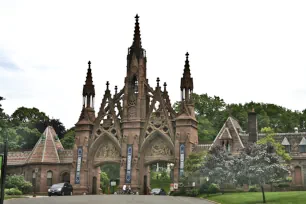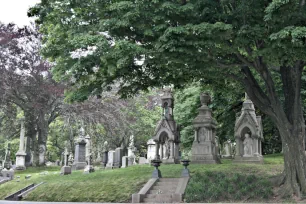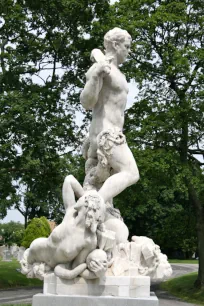Green-Wood is a large cemetery in Brooklyn. In the nineteenth century, when it was the largest cemetery in the world, this was the place to be buried and many of New York’s politicians, artists, military leaders and sportsmen have found their last resting place here.



Despite its enormous size – it covers an area of about 193 hectares / 478 acres – Green-Wood is rarely on visitors’ radar, despite it being one of the most interesting off-the-beaten-track sights in New York. It has plenty to offer: history, architecture and nature.
History
Green-Wood Cemetery was founded in 1838 in what was at the time the independent City of Brooklyn. It was one of the first cemeteries in the country to provide a rural setting with lots of space and greenery, as opposed to the overcrowded churchyards in the center of the city. Soon, Green-Wood Cemetery became the place to be buried for New York’s rich and famous.
By the mid-nineteenth century, Green-Wood was one of the most popular tourist attractions in the country, and it attracted some half a million visitors every year. Those visitors loved the cemetery’s park-like atmosphere with plenty of trees, hills and ponds. Until the completion of Central Park in Manhattan and Prospect Park in Brooklyn, this was also the most popular park in the city.


The Cemetery Today
Today the large cemetery is as beautiful as ever. Though not as popular anymore as in its heyday, the cemetery still attracts plenty of visitors who love to walk along its thirty kilometers (close to 20 miles) long network of paths that wind around the numerous hills.
The abundance of graves, tombs and mausoleums in a variety of architectural styles ensure a walk here is never dull. You’ll find many mausoleums built like Classical style temples, and there’s also a surprisingly large amount of Gothic structures. Some of them are really ornate and resemble medieval chapels. Other sepulchral monuments were inspired by Egyptian monuments – obelisks were particularly popular – and some are even modern in design.
The Gate
The most impressive monument in Green-Wood is not a mausoleum, but the monumental gateway at 25th Street. The imposing entrance was built between 1861 and 1865. Its late Revival Gothic style is reminiscent of medieval church architecture, so it’s no surprise that the architect, Richard Upjohn, who designed the gate in cooperation with his son, is best known for his churches.
The brownstone gate has three pinnacled towers that divide the two pointed arch entrances. The tall central clock tower is supported by spectacular flying buttresses. The arches are decorated with Gothic tracery; right below are panels with sandstone relief sculptures that depict biblical and allegorical scenes. Adjoining the gate on either side are two pavilions that house a visitor center and cemetery office.

The Chapel
Once past the entrance gate, one soon stumbles upon the most beautiful building in the cemetery: the Gothic Revival chapel. The chapel was built in 1911 after a design by the renowned architecture firm of Warren and Wetmore, best known for their involvement in the creation of the Grand Central Terminal. They were inspired by the Tom Tower, a famous bell tower in Oxford, England. Inside, note the beautiful stained-glass windows and the chandelier, which is suspended from the rib-vaulted ceiling.
Other Sights


There are many other sights in Green-Wood, not in the least the imposing mausoleums and tombs.
The odd one out is a large sculpture group entitled ‘Civic Virtue’. The statue, part of a monumental fountain, was intended as an allegorical representation of Virtue triumphing over Treachery and Corruption. In 1922 the fountain was unveiled in City Hall Park, only to be met with controversy – feminists considered the imagery of a male (representing virtue) standing over mermaids (representing vice) as oppressive towards women. In 1941 the sculpture group was moved to Queens, but another generation of feminists took the allegorical representation too literal and finally at the end of the twentieth century it was banned to Green-Wood Cemetery.
Another monument, the Altar to Liberty, marks the top of Battle Hill, the highest point in Brooklyn. The monument shows the Roman goddess Minerva, who lays a wreath on an altar. A panel on the altar dedicates the monument to the Battle of Brooklyn, the first major battle in the American Revolutionary War after the Declaration of Independence. The battle, fought on August 27, 1776, ended in a decisive victory for the British troops.

Famous Residents
More than 560,000 people are interred in Green-Wood Cemetery. It became popular as a burial place with New Yorkers after the remains of governor DeWitt Clinton were moved here in 1844. Being buried in Green-Wood became a status symbol. The New York Times even claimed in 1866 that every New Yorker’s ambition was to live on Fifth Avenue and be buried in Green-Wood.
Some of the famous New Yorkers buried here include the notoriously corrupt politician William M. “Boss” Tweed, newspaper tycoon Horace Greeley, composer and conductor Leonard Bernstein and the celebrated glass designer Louis Comfort Tiffany. The entire Steinway family – of piano fame – is entombed in a massive mausoleum. You can also find the graves of many military generals, sports legends, businessmen and artists. Pick up a map at the entrance to find the location of the graves of some of the most famous people interred at Green-Wood.

